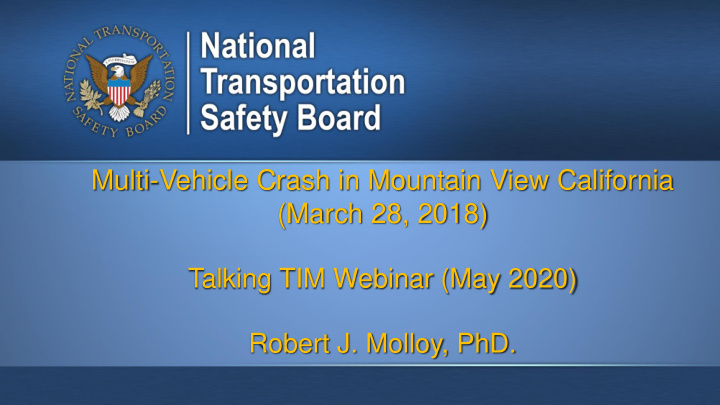



Multi-Vehicle Crash in Mountain View California (March 28, 2018) Talking TIM Webinar (May 2020) Robert J. Molloy, PhD.
Presentation Overview • Automation in theory • Vehicle automation • The crashes • The safety areas • Actions needed 2
The Theory Automation can eliminate human error by eliminating the human from the loop
Crashes Involving Driver Error >90%
The Reality Automation can significantly increase productivity, efficiency, reliability, throughput, and safety but the downside . . .
The Downsides “In their efforts to compensate for the unreliability of human performance, the designers of automated control systems have unwittingly created opportunities for new error types that can be even more serious than those they were seeking to avoid.” Prof. James Reason, University of Manchester (UK) 6
Vehicle Automation 7
Levels of Automation Conditional Full No Driver Partial High Automation Automation Automation Automation Assistance Automation Supervise Maintain Understand Intervene automation awareness limitations when needed 8
Autopilot Description • Monitors travel path • Maintains set cruise speed • Maintains vehicle’s position in travel lane • Brakes when detecting slower-moving vehicles ahead • Decelerates and follows vehicles ahead at a predetermined following interval 9
The Crashes 10
Mountain View • Friday, March 23, 2018 • 9:27 a.m. • Mountain View, California • US-101 / SR-85 interchange • 2017 Tesla Model X SUV • 38-year-old driver • Partial automation “Autopilot” engaged 11
Crash Sequence SR-85 HOV exit lane US-101 south lanes N S Crash attenuator was collapsed and nonoperational prior to the crash Source: Caltrans 12
Crash Sequence Crash attenuator N S Lead vehicle Time to crash: 7.9 seconds Speed: 64.3 mph Lead vehicle: 83.7 feet Distance to crash: 748 feet 13
Crash Sequence Crash attenuator N S Time to crash: 5.9 seconds Lead vehicle Steering: 5.6 degrees left Speed: 64.1 mph Lead vehicle: 82 feet Distance to crash: 560 feet Indication: Hands-off steering wheel 14
Crash Sequence Crash attenuator N S Time to crash: 3.9 seconds Speed: 61.9 mph Lead vehicle: None detected Lead vehicle Distance to crash: 375 feet (no longer followed) Vehicle begins to accelerate Hands-off steering wheel indicated 15
Crash Sequence Impact speed: 70.8 mph
Crash Sequence Source: S. Engleman 17
Other NTSB Investigations Lessons learned from three other Tesla crashes were incorporated into the Mountain View crash investigation: • Williston, Florida • Delray Beach, Florida • Culver City, California 18
Williston, Florida (May 7, 2016) 19
Delray Beach, Florida (March 1, 2019) 20
Culver City, California (January 22, 2018) N S Source: CHP 21
The Safety Issues 22 22
Autopilot Performance • Lane markings were worn • Autosteer vision system likely lost lane line prediction • Identified stronger lane line • Steering movement likely due to vision system limitations 23
Crash Attenuator Performance • Damaged 11 days earlier Barricade Damaged crash • Prius collision attenuator • Driver survived • CHP did not notify CalTrans • CalTrans repair not timely Source: CHP Barricade and cones placed in advance of attenuator prior to crash 24 24
Automation Issues • Operational design domain (ODD) • Monitoring driver engagement • Collision avoidance system (CAS) 25
Operational Design Domain • Conditions in which an automated system is designed to operate - Geographic location, roadway type and markings, speed range, weather conditions • ODD constraints are designed to reduce the effect of Level 2 limitations 26
ODD Constraints • Autopilot, stated in vehicle manual, is - Not for use on city streets, in constantly changing traffic conditions, on winding roads with sharp curves - For use only on divided highways with limited access • The system allows a driver to use Autopilot outside its ODD • Level 2 system limitations are industry-wide 27
Geographic ODD: Mountain View • Crash location - Highway with center median divider - Limited access (no cross-traffic) - Major interchange (changing traffic conditions) • Tesla stated ODD does not apply to Level 2 systems 28
Geographic ODD: Williston and Delray Beach • Williston crash location - Outside ODD of Autopilot • Delray Beach crash location - Highway with center median divider - Not limited access (has cross-traffic) - Outside ODD of Autopilot 29
Monitoring Driver Engagement • Driver monitors environment in Level 2 systems - Tesla stated that Autopilot can be used on undivided roads with an attentive driver - Risk of automation complacency and misuse • Tesla’s method of monitoring driver engagement - Driver-applied steering wheel torque - System provides series of warnings to driver (visual, 3 stages of auditory warnings) 30
Driver Engagement: Mountain View • The crash trip lasted 28.5 minutes • Lack of responsiveness indicates distraction and • Two visual warnings; one auditory warning • Autopilot was engaged for the last nearly 19 minutes overreliance on automation 31
Driver Engagement: Other Level 2 Crashes • Williston and Delray Beach, Florida; Culver City, California - Driver-applied steering wheel torque not detected at time of impact - Prolonged inattentiveness by drivers - Drivers were ineffective monitors • Humans are poor monitors of automation • Monitoring of steering wheel torque is a poor surrogate measure of driver engagement 32
Automation: The Path Forward 33
Needed ODD Improvements • Manufacturers should include system safeguards to limit the use of Level 2 systems to conditions for which they are designed (H-17-41) • NHTSA should verify that manufacturers are incorporating the safeguards (H-17-38) - Lack of guidance on identifying ODD 34
Needed Driver Monitoring Improvements • Manufacturers should implement more effective means of monitoring driver engagement when using Level 2 • NHTSA and SAE should develop performance standards for driver monitoring systems to address automation complacency • An engaged driver remains a critical component even with advanced driver assistance systems 35
Summary • Technology offers hope • Automation must consider the human • Infrastructure must support the automation 36
Robert Molloy, PhD. Director Cell 202-320-6294 Email molloyr@ntsb.gov
Recommend
More recommend